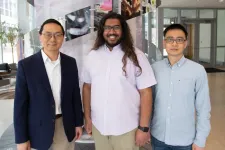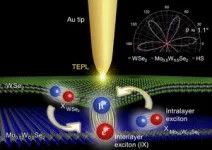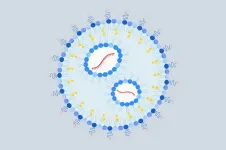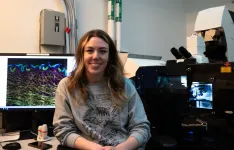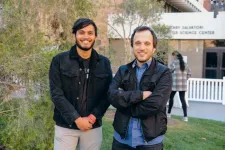(Press-News.org) Living organisms produce a myriad of natural products which can be used in modern medicine and therapeutics. Bacteria and other microbes have become the main source for natural products, including a growing family called ribosomally synthesized and post-translationally modified peptides, or RiPPs. The labs of Douglas Mitchell (MMG), John and Margaret Witt Professor of Chemistry, and Huimin Zhao (CABBI/BSD/GSE/MMG), Steven L. Miller Chair of Chemical and Biomolecular Engineering, at the University of Illinois Urbana-Champaign have been working in tandem to identify and analyze new RiPPs that could be good candidates for drug development and therapeutics.
“Compared to other classes of natural products such as alkaloids, terpenes, or polyketides, RiPPs are still underexplored, partly because their biosynthetic gene clusters are quite small and were often overlooked in the past,” said Zhao. “So we decided to develop new technologies to discover novel RiPPs with biological activity.”
“Now that we're in the genomics era, we’re realizing just how widespread these groups of natural products are, especially in bacteria,” said Shravan Dommaraju, a PhD candidate in Mitchell’s lab. “We’re basically in this exploration phase, where we know that they're out there, and the goal is to see how many we can find because we don't know what they all do yet.”
In a new paper by the Zhao and Mitchell labs, with co-first authors Dommaraju and Hengqian Ren, a postdoctoral researcher in Zhao’s lab, the team reported the discovery of a unique, novel class of RiPPs, which they have named “daptides.” Unlike most peptides which have one positively charged and one negatively charged end, or “terminus,” daptides instead have two positively charged termini.
“A textbook would say that a peptide has an amino terminus and a carboxy terminus, but in our case, we found a ribosomal peptide that has two amino termini,” said Ren. “Because there's positive charge at both ends, this gives daptides some interesting bioactivities.”
The researchers explained that while this change in termini may seem small, the positive charge of both termini gives daptides the potential to interact with negatively charged objects, such as cell membranes. To test this, the team added the daptides to a dish with red blood cells. They found that the daptides showed hemolytic activity, meaning that they disrupted the membranes of the cells, causing them to rupture. Zhao explained that hemolytic activity is rarely found in the RiPPs the team works with, and that antimicrobial or antifungal activity is much more common.
“We were thinking about the structure and what is the evolutionary drive to cause a peptide to lose the negatively charged C terminus and replace it with a positively charged amino group,” Dommaraju said. “From an engineering perspective, if you wanted to make a peptide that can interact with a membrane, you would stick a bunch of positive charges on it. And that's actually what led us to testing this for hemolytic activity because we knew that it had this modification that should allow for that.”
Finding new RiPPs is no easy task. First the researchers use bioinformatics to compare and try to identify gene clusters that could produce potential RiPPs. Then they clone the targeted cluster and place it into an organism to be expressed, after which they can check for any natural products produced. Even after obtaining the products, there is still the question of what the products do and how they are produced, which can be tested with bioassays, gene knockouts, and a variety of other tests. But Dommaraju says the labs each play to their expertise when collaborating to streamline the process.
“So on a project like this, the Mitchell lab does the bioinformatics and identifies cool gene clusters, and the Zhao lab gets the synthetic biology system up and going to express these peptides and make them,” Dommaraju explained. “So then we are able to tag team our experience and the overlapping stuff that we do to get the project to the finish line.”
The researchers say the next steps are to understand the enzyme functions of the daptides, and use bioinformatics analysis to see if there are other combinations of genes associated with daptide production. Directions for further studies in the future include exploring potential therapeutic uses for daptides, and the ecological role that daptide production has for the bacteria that make them. However, both Ren and Dommaraju agreed that their interests in future experiments with RiPPs extends beyond just daptides, as there are still more classes to discover.
“We’re interested in using our bioinformatics tool to find as many different natural product classes as we possibly can,” said Ren. “There is such a large frontier right now of undiscovered RiPP classes, and it's exciting to be at the cutting edge, discovering new possibilities. There’s always a chance that the next product you find might be a major therapeutic development!”
The paper is published in Nature Communications and can be found at DOI 10.1038/s41467-023-37287-1. The work was funded by National Institute of Allergy and Infectious Diseases (NIAID) and the National Institute of General Medical Sciences (NIGMS).
END
Researchers discover new class of ribosomal peptide with hemolytic activity
2023-04-05
ELSE PRESS RELEASES FROM THIS DATE:
Nanoparticle with mRNA appears to prevent, treat peanut allergies in mice
2023-04-05
Peanut allergies affect 1 in 50 children, and the most severe cases lead to a potentially deadly immune reaction called anaphylactic shock.
Currently, there is only one approved treatment that reduces the severity of the allergic reaction, and it takes months to kick in. A group of UCLA immunologists is aiming to change that.
Taking inspiration from COVID-19 vaccines as well as their own research on the disease, they created a first-of-its-kind nanoparticle — so small it’s measured in billionths of a meter — that delivers mRNA to specific cells in the liver. Those cells, in turn, teach the body’s natural defenses to tolerate ...
5 Questions with CNSI’s Haley Marks
2023-04-05
Haley Marks is a project scientist for the Advanced Light Microscopy Lab (ALMS) at the CNSI at UCLA. She is a biomedical engineer with a specialty in nano-biosensor research, translational medicine, and optics education.
Since joining CNSI in 2022, Haley has served as a technical expert, providing advanced light microscopy training and services to ALMS users. Here she works on developing and optimizing ALMS’s existing super-resolution and high-speed optical methods, developing strategies and imaging tools for in vivo imaging, and optimizing and disseminating computational imaging techniques.
Haley has a passion for all things photonics, and enjoys 3D printing, materials ...
Young dog owners tend to cope well when their beloved pooch misbehaves, new study reveals
2023-04-05
A new study published in the CABI journal Human-Animal Interactions reveals that young dog owners tend to cope well when their beloved pooch misbehaves.
Past studies suggest that around 90% of dogs display undesired behaviours such as aggression and disobedience, but little is known about the impact of this on young people’s experiences and accompanying emotions.
A team of scientists interviewed young dog owners in Canada, aged 17 to 26 years, to try and determine their experiences with their pets and their coping strategies in response to bad behaviour.
This included barking occasional and persistent barking and, in extreme cases, being aggressive towards other dogs ...
Robots predict human intention for faster builds
2023-04-05
Humans have a way of understandings others’ goals, desires and beliefs, a crucial skill that allows us to anticipate people’s actions. Taking bread out of the toaster? You’ll need a plate. Sweeping up leaves? I’ll grab the green trash can.
This skill, often referred to as “theory of mind,” comes easily to us as humans, but is still challenging for robots. But, if robots are to become truly collaborative helpers in manufacturing and in everyday life, they need to learn the same abilities.
In ...
Hot probe tip contributes to making “transformer” semiconductor particles
2023-04-05
How can we make wearable devices like Spiderman’s suit that are thin and soft yet also feature various electrical and optical functionalities? The answer lies in producing novel materials that go far beyond the performance of existing materials and developing technology that enables the precise control of the physical properties of such materials.
Separating transition metal dichalcogenide (TMD) into a single layer just like graphene makes it transform into a thin, two-dimensional (2D) film material that exhibits the characteristics of highly performing semiconductors. By stacking two disparate ...
Series of new studies refute assumptions about link between power and concern about reputation
2023-04-05
Contrary to earlier research findings, people of power - think about politicians, celebrities or bullies in school - turn out to be no less concerned about their reputation, compared to those who have less influence and control within the society.
Previously, it has been assumed that since those who have the upper hand in the society - unlike the ‘powerless’ - are able to get away with commonly unacceptable behaviour (e.g. aggression and exploitation), would care less about any potential damages to their reputation.
However, a recent study by scientists at the University of Kent (United Kingdom) ...
Society matters LIVE: Lab made meat on the menu?
2023-04-04
• Research at Aston University focuses on both creating lab-based meat and its psychological acceptance
• Dr Eirini Theodosiou and Dr Jason Thomas will be speaking at April’s Society matters LIVE event
• Lab made meat on the menu? will take place at Cafe Artum in Hockley Social Club on Thursday 27 April.
Lab made meat will be the topic of the latest Society matters LIVE event from Aston University at Café Artum at Birmingham’s Hockley ...
Students use machine learning in lesson designed to reveal issues, promise of A.I.
2023-04-04
In a new study, North Carolina State University researchers had 28 high school students create their own machine-learning artificial intelligence (AI) models for analyzing data. The goals of the project were to help students explore the challenges, limitations and promise of AI, and to ensure a future workforce is prepared to make use of AI tools.
The study was conducted in conjunction with a high school journalism class in the Northeast. Since then, researchers have expanded the program to high school classrooms in multiple states, including North Carolina. ...
DZIF-project-derived start-up “EBViously“ announces first details of its EBV vaccine candidate
2023-04-04
EBViously, a spin-off from Helmholtz Munich (HMGU), is led by world-leading experts in Epstein-Barr virus biology, genetics, and immunity and was founded to develop a safe and highly effective preventive vaccine against a range of diseases caused by Epstein-Barr virus (EBV), including infectious mononucleosis, immune disorders, multiple sclerosis, and various cancers. The spin-off is based on a project of HMGU supported by the German Center for Infection Research (DZIF). The project leading to the spin-off was co-funded by the DZIF to enable GMP manufacturing ...
Preventing urban flooding in the face of climate change
2023-04-04
Planners have come up with many innovative ways to prevent flooding caused by heavy downpours — from planting rain gardens to installing green roofs.
But in many cases, nothing works quite as well as a simple hole in the ground — a detention basin.
That’s the finding of an analysis by University of Cincinnati geography students in a research collaboration with the Hamilton County Conservation District.
Lead author and UC College of Arts and Sciences doctoral student Man Qi said cities are developing new ways to trap rainwater and direct it where it’s most wanted, especially during droughts. They call these low-impact development practices, which ...
